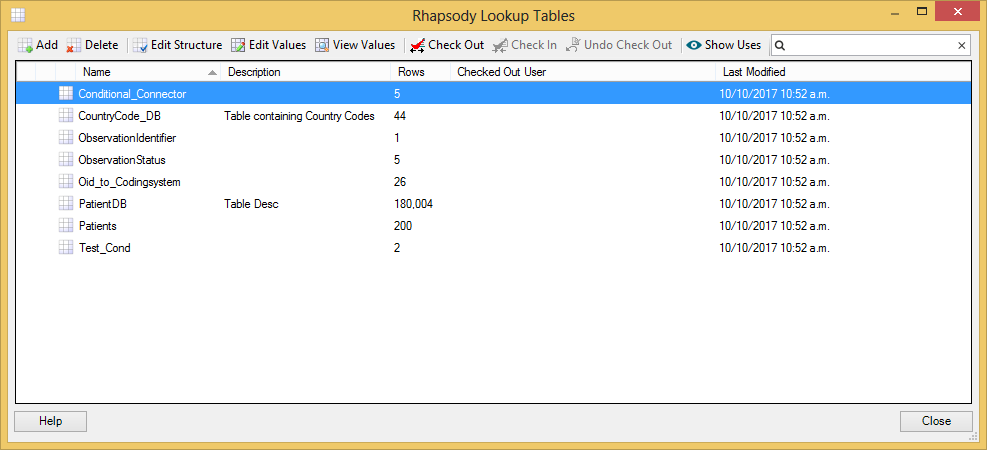Menu Path: View> Lookup Tables |
Toolbar: >Lookup Tables |
Read Access Rights :
|
Write Access Group Rights:
|
A lookup table contains the values you want to 'look up' and the translation, and enables values to be mapped based on managed data lookups. Lookup tables in Rhapsody are multi-column data tables that can be used to match data in multiple columns and return the value of another column. If there are multiple matches, a lookup table can return the first match only or all matches. Failed lookups can be logged, and counted, so that the correct values can be added at a later time.
Lookup tables can be edited through Rhapsody IDE and the Management Console, as well as the remote monitoring APIs, and can be transferred between systems using RLC files. Additionally, the managed lookup tables can be imported and exported using Comma Separated Value (.csv) files. Any changes made to the tables take effect immediately, that is, components that use the tables do not have to be reconfigured.
Thus, Rhapsody's lookup tables provide a simple code-mapping solution without the need for a database.
Importing CSV files with very high row counts into lookup tables will not be successful if client hardware has insufficient memory, or the Rhapsody engine has a small heap size. Depending on the hardware configuration, there is a practical limit of approximately 600,000 rows.
You can assign lookup tables to a route using the following Rhapsody objects:
- Any filters and communication points using JavaScript (such as the JavaScript filter, HL7 Message Modifier filter, Freemarker Mapper filter, and JavaScript TCP Client and JavaScript TCP Server communication points). Refer to LookupTable Object and ColumnValue Object for details.
- Conditional and JavaScript connectors.
- The Mapper filter (refer to Using Map Designer for Lookups for details).
- Intelligent Mapper mapping projects (refer to the Intelligent Mapper filter).
- Web service clients.
The Lookup Tables Manager provides a central location for managing lookup tables:
- Adding or Deleting Lookup Tables
- Defining the Structure of a Lookup Table
- Managing Lookup Table Values
- Importing or Exporting Lookup Tables
- Finding and Replacing Lookup Table Values
- Handling Lookup Failures
- Using Map Designer for Lookups
- Showing the Uses of a Lookup Table
- Lookup Table Examples
Viewing Lookup Tables
The Lookup Tables Manager lists the lookup tables in Rhapsody, and enables you to easily create new tables, delete existing tables, as well as edit the metadata (properties), structure and values of a table.
To launch the Lookup Tables Manager, navigate to View>Lookup Tables (or press Ctrl+Shift+L):
The Lookup Tables manager displays the following information:
Column |
Description |
|---|---|
[Not labeled] |
The icon indicates that the lookup table is checked out for editing. |
Name |
The name of the lookup table. |
Description |
A description of the lookup table. |
Rows |
Number of rows in the lookup table. |
Checked Out User |
If the lookup table is currently checked out, this column identifies the user who checked it out. |
Last Modified |
The date and time the lookup table was last modified. |
Managing Lookup Tables
You can perform the following actions from the Lookup Tables Manager:
| Action | Description |
|---|---|
| Add | Add a lookup table. |
| Delete | Delete a lookup table. |
| Edit Structure | Edit the structure of a lookup table via the Lookup Table Structure dialog. |
| Edit Values | Add or edit values in a lookup table via the Edit Lookup Table Values dialog. From the dialog, you can also:
Double-clicking on a lookup table name also opens the Edit Lookup Table Values dialog. |
| View Values | View the values and lookup failures associated with a lookup table via the View Lookup Table Values dialog. From the dialog, you can also: |
| Check Out | Check out a lookup table. |
| Check In | Check in a lookup table. |
| Undo Check Out | Undo a check-out of a lookup table. |
| Show Uses | Display the components or objects a lookup table is being used in. |
| Filter | Perform text-based filtering to filter the list of displayed lookup tables. |



